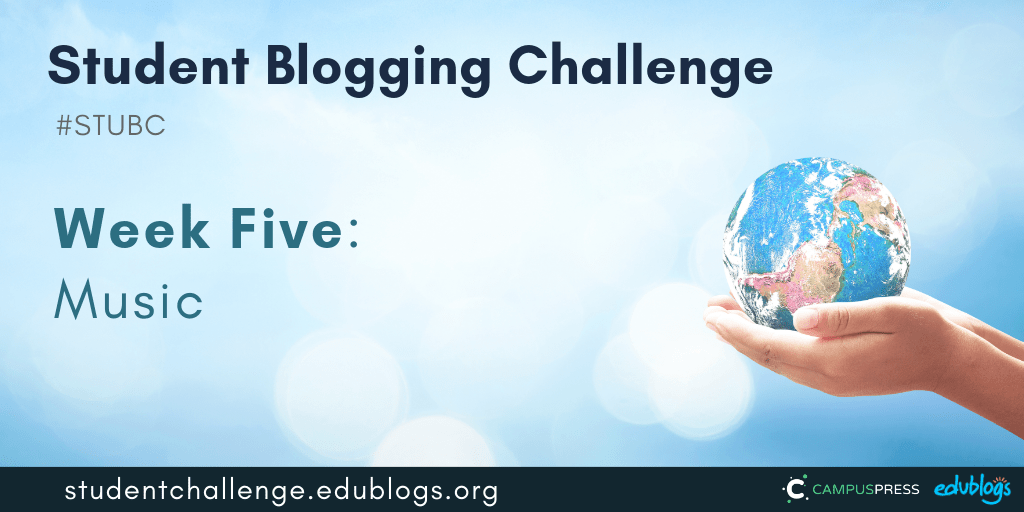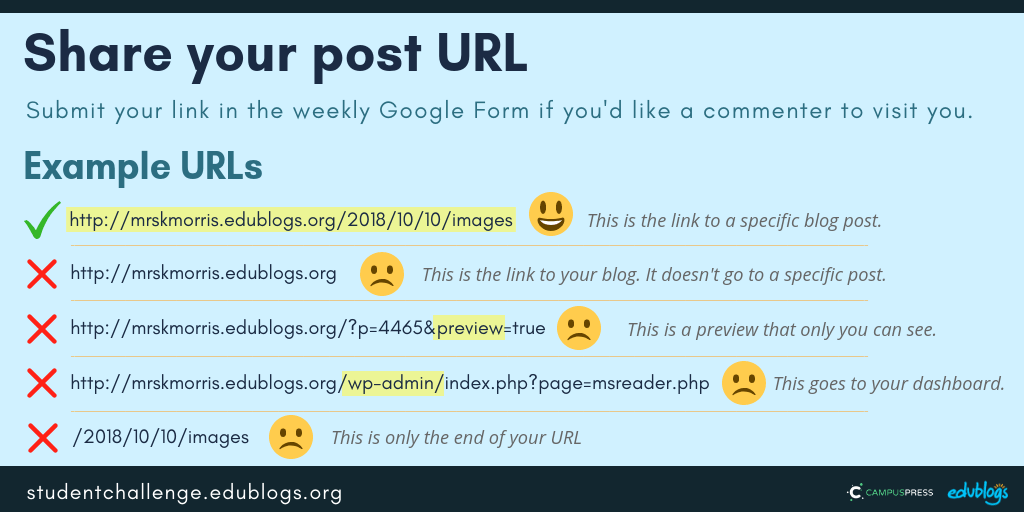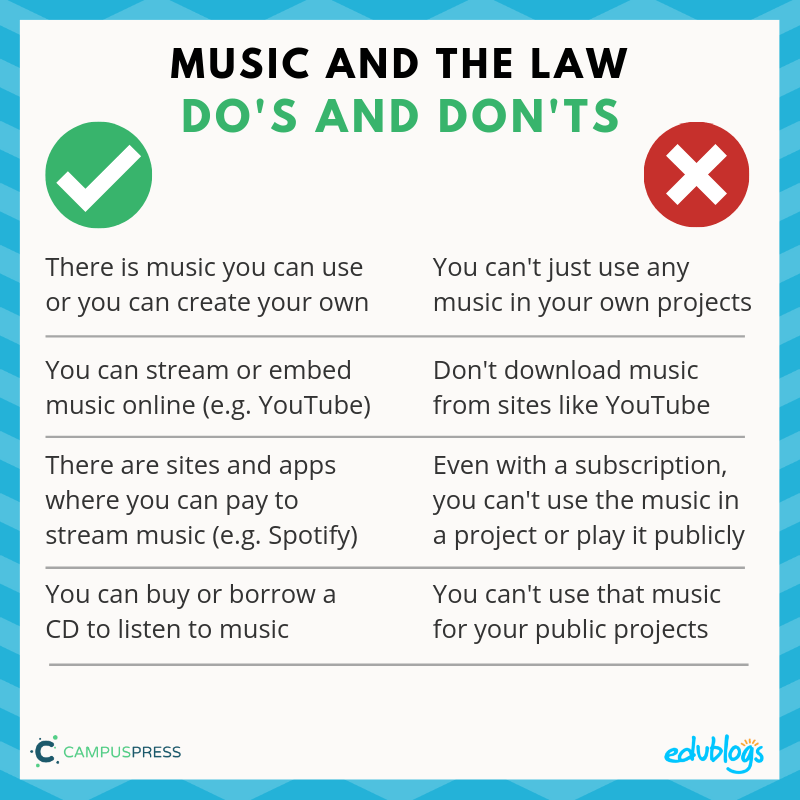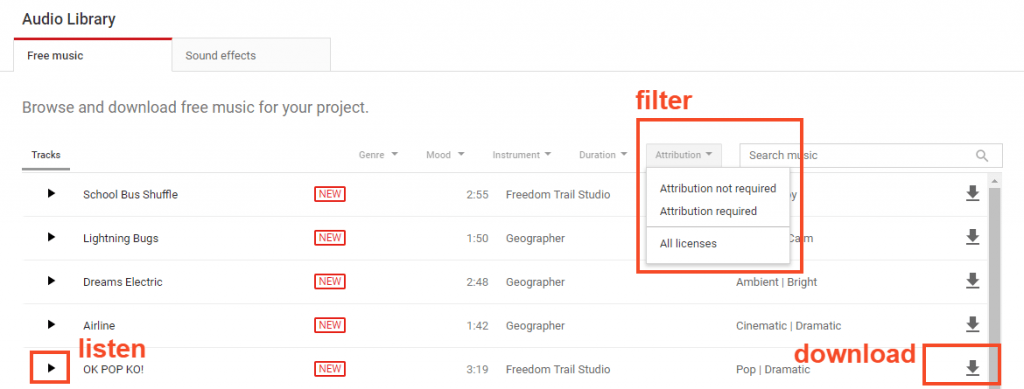Music is something that can connect people, no matter where you live, what language you speak, or how old you are.
This week, we’re going to discuss all aspects of music — what we like, what we don’t like, how we use music, and using music legally.

Week Four Recap
 There were so many great posts submitted again by classes and students.
There were so many great posts submitted again by classes and students.
You can find them all here (or click on the week 4 box on the sidebar).
Let’s take a look at just some of the fantastic work we spotted last week:
- Ally wrote about her passion for physics and philosophy of the universe.
- Mrs. Kundhi’s grade 1 students drew pictures and copyrighted them.
- Mrs. Caudill wrote a post to showcase some great student posts.
- Julia wrote about her weird cats and included a video.
- Brooke took some photos around her town.
- Abby used images and words to explain what to look forward to now Halloween is over.
- Sedelstein wrote about commenting on others’ blog posts.
- Adelle shared some great images of her grandmas’s playhouse.
- Karis wrote about wolves in Yellowstone National Park.
- You can view more great work on our 2019 Student Blogging Challenge Flipboard.
Reminders
Here are a few important reminders:
- The Google Forms for weeks 1-3 are now closed. You can still submit posts for earlier tasks in later Google Forms if you’re catching up. The week 4 Google Form will close on Wednesday November 6 (they stay open for 10 days).
- Please keep approving comments quickly. Try to write a reply to your comments, even if you only have time for a short thank you.
- To become a better blogger, before you publish consider: have I proofread? Is my text broken up in short paragraphs (bullet points can be good too)? Do I have an image?
- Consider adding the subscribe by email widget — if you use Edublogs or CampusPress, this tool lets readers sign up to get an email notification every time you write a new post. Learn more here.
- Music global project idea— teachers, if you’re inspired to take the music topic even further, we have been told about a project called the “World Peace Song Group”. In this project, teachers and students living in different parts of the world collaborate to create lyrics that express peace. Check out the Facebook group for more.
Let’s Look At Music
What sort of music do you like?
- Pop?
- Rock?
- Classical?
- Country?
- Alternative?
- Jazz?
- Dance?
- Hip hop or rap?
There are so many different types of music enjoyed around the world.
As Greek Philosopher Plato apparently said,
Music gives a soul to the universe, wings to the mind, flight to the imagination and life to everything.
Music and the Law
Remember back in week 3 we discussed how you can’t just use any image that you find online? Well, the same applies for music.
Most music is protected by copyright. So you can’t use it for your own digital projects without permission or paying for a special license.
Listening to music
Not so long ago, when people wanted to listen to their favourite song, they had to wait until it came on the radio or buy the CD/cassette/record.
Now there are choices but it’s important to know what you can and can’t do with music.
Using music in projects
Normally, you can’t just use any music you like in something you’re creating — like a video.
However, in most countries, you are allowed to copy music to add to a video if:
a) it’s for educational purposes and
b) you’re not sharing your video publicly (or selling it!)
So, if you make a video with music that’s protected by copyright, it’s not okay to publish this on a public blog. And you couldn’t show your video at a public event. However, it’s okay if you’re just showing the video to your teachers and parents.
Hopefully you do want to share your work with a public audience. That’s what this challenge is all about! Don’t worry. You can still use music. I’ll share some options below.
Note: This is the case in Australia and the US but if you live in another country you may need to check your own guidelines.
Paying for music
There are popular sites and apps where you can pay to download music legally — for example, Apple Music, Google Play Music, and Spotify.
You can listen to your downloaded music yourself, but can’t upload the music to your blog or to a video or other project you’re working on.
You also can’t use it publicly (e.g. at a school event, store, or public event).
Streaming music
It’s fine to stream music online on sites like YouTube (although remember, YouTube is 13+) but it’s not usually legal to download the audio from a YouTube video as explained in this article.
Also, streaming music in this way is meant for personal use — not for a public broadcast. As Spotify says,
…it’s not possible to use Spotify in public places (such as bars, restaurants, stores, schools, etc.). You may only make personal, non-commercial, entertainment use of the content.
Most streaming services are similar.
Embedding music
Embedding a video from a site like YouTube or Vimeo into your blog is usually allowed.
As Richard Byrne says,
If the host provides an embed and you embed it using their code according to their rules (usually that means not trying to hide branding), you can embed it without violating copyright.
CDs or digital music?
You can also listen to music by buying a CD or borrowing one from the library. Although digital music is becoming a lot more popular than CDs in many parts of the world.
Again, you can’t copy the music from a CD and use it for another project (e.g. upload it to your blog or add it to a public video).
Confused? Here’s a summary of the do’s and don’ts you need to remember
Remember, I’m no legal expert and things are different in different countries so please contact me if you have any extra information. We can all learn together!
Where to find music and clips that you are allowed to use
Just like with images, there are options for students and teachers who need music or sound clips for a video, slideshow, or other digital project they’re working on.
Let’s take a look at three …
Dig CC Mixter
Dig CC Mixter offers thousands of hours of free music.
The music on this site has different Creative Commons licenses so you need to check whether you need to attribute the music or not (attribute means saying who made the music and where it’s from etc).
Educational Blogger Richard Byrne’s video below explains how to use Dig CC Mixter and filter by license.
BBC Sound Effects
During 2018, the BBC made over 16,000 sound effects available to use for personal, educational, or research purposes.
You can browse by category to find the sort of sound effect you’re after for your project.
You should put a link in your project or blog post to say that your sound effects were from the BBC and link to their site.
Here is an example of a sound clip. This is the sound of the surf at Bondi Beach, Sydney, Australia.
bbc.co.uk, copyright 2019
YouTube Audio Library
YouTube also has a great library of music you can use although remember YouTube is 13+.
Visit the AudioLibrary to browse the selections.
If you click on Attribution, you can filter your results to find music that doesn’t need to be attributed.
You can preview the music to see what it sounds like and download the music you like.
Here’s an example called Sunshine in my Heart by Jingle Punks.
Want more places to find free music?
Check out these sites from Richard Byrne for more sites and details:
- A Good Source of Free Music for Multimedia Projects
- A Guide to Finding Media for Classroom Projects
- The Free Music Archive is Closing – But Not All is Lost
Week Five Tasks
This week you can choose from a list of 8 ideas to create a post about music. Or you can come up with your own idea!
Important: Please make sure you write a blog post and don’t just submit the link to a quiz or song. Otherwise, commenters and other visitors won’t be able to leave a comment.

8 Prompts For Your Post About Music
Choose one or more of these ideas to create a post about music. Or, you might have your own idea!
1) Create a survey about music (opinions)
Create a poll to survey your readers (Google Forms is a good way to do this or you could use a tool like Crowd Signal).
Alternatively, you could write some questions that you’d like readers to answer in a comment.
Your survey questions could be about:
- Your favourite music genre
- Your favourite artists or groups
- Would you rather? (e.g. Would you rather Ariana Grande or Billie Eilish? Would you rather classical music or rap?)
Idea: When your survey is completed, you could share a summary of your findings. I love a tool called Beam for making simple charts.
2) Create a quiz about music (facts)
Quiz your readers about anything music related. Perhaps your quiz could include questions like:
- Facts about artists (year they were born, or first number one hit)
- Facts about instruments
- Music theory
- Questions about a certain genre or period of time (e.g. 1980s music)
Google Forms is great for making quizzes but please make sure it’s public. You could also make a Google Slides presentation. The question could be on one slide, and the answer on the next (or all the answers could be at the end of the presentation).
Remember to please make sure any Google Forms/Slides/Docs etc. are public.
3) Tell us about an instrument
Do you have a favourite instrument? Or perhaps there is an instrument that fascinates you and you might like to do some research and write a post about it.
You might include things like:
- Construction or appearance
- History
- Technique or how to play it
- Famous works or artists
- Classification or family of instruments (e.g. strings, or percussion)
Don’t forget to include an image or embed a video.
Example: Ash wrote a post about the ukelele.
4) Research a famous artist or group
Find out more about a singer, songwriter, musician, or group. This might be someone who is popular now or performed long ago.
Share some interesting facts in a post.
Bring your research to life with an image or video.
5) Make a playlist
Music lovers have enjoyed making their own playlists for years. A playlist can celebrate a certain artist, genre, or mood.
Write a blog post that includes a playlist of your favourite songs. Don’t forget to explain why you like each song and why it’s part of your playlist.
Example: Principal Meredith Akers made a playlist by embedding YouTube videos into her blog post.
6) Discuss music and the law
Many people don’t realise that by using music illegally, you are putting artists at a disadvantage because they are not getting paid for their work.
Do some research and write an article about the downsides of using music illegally.
Alternatively, you might like to write a post about do’s and don’ts of using music legally. You might be able to teach others who aren’t aware that there are rules we need to abide by.
7) Guess the artist, song, or instrument
Guessing games are fun!
Give your readers some clues as they scroll down the page and have them guess the artist, song, or instrument.
You could put each clue on a slide of a Google Slides presentation if you prefer (just remember to make sure your Slides presentation is public).
Invite your readers to put their guesses in a comment.
8) Make some music
We don’t just have to talk about music or listen to others’ music. Why not make your own. There are lots of apps and websites where you can make music.
One suggestion is Google’s Song Maker
Play around with it to make a tune and then click Save in the bottom right-hand corner.
Next, you can copy the embed code. Another option is to copy the link to your song if you don’t want it embedded in your post.
In your blog post, go to Add Media > Insert Embed Code
Paste your embed code and press Insert Into Post
Your song will appear!
When You’ve Published A Post, It’s Time To Visit
As always, an important part of the challenge is to connect with others. You never know what you might learn or who you could connect with!
When you’ve finished your post, choose a couple of blogs to visit and leave a quality comment.
Remember to ask a question and check back to see if they replied to you (most platforms have a box to tick so you can get an email when there is a follow-up comment).
You will find the link to the week 5 participants’ posts on the sidebar of this blog on Tuesday.
Example Posts
Last time we ran this topic, some students combined more than one activity. Here are just a few examples of some student work.
- Nora from the USA wrote about a South Korean girl group called Loona and made music playlists.
- Yueshi from Australia made a quiz to test your knowledge of music and shared a song she created.
- Evanne from Taiwan created a music poll.
- Marie from the USA made a short quiz in Google Slides and shared a song she made.
- Mrs. Matveyeva’s Class in Kazahkstan shared some interesting information about Kazahk music and instruments.
Submit Your Post URL ⬇
If you’d like a commenter and others to visit your post about music, fill in the form below.
Important: Please make sure you write a blog post and don’t just submit the link to a quiz or song. Otherwise, commenters and other visitors won’t be able to leave a comment.
This video shows you how to find your URL…
Note, this isn’t a real class blog. Just one I used for testing 😉
This graphic below should help you understand what a post URL looks like if you’re using Edublogs/CampusPress/WordPress
 The Google Form
The Google Form
Edit: The week 5 Google Form is now closed. Feel free to enter the URL of your work in a later form that’s still open.
Next week’s topic: Emojis! 😎
What's on this page?
- Week Four Recap
- Reminders
- Let’s Look At Music
- Week Five Tasks
- Submit Your Post URL ⬇


Heres my google sounds thingy: https://musiclab.chromeexperiments.com/Song-Maker/song/5812638556618752
Hi Sam,
If you missed sending your post about music to week 5, just submit it to week 6. The commenters will be happy to read your post. 🙂
Marg
Student blogging challenge volunteer
1marg.edublogs.org
Hi kathleen,
Can You please change my blog url
I changed it
Here is the link:
http://samanthas4k.edublogs.org
Hi Samantha,
It’s Marg. I am a volunteer with the blogging challenge. I would love to change your blog url for you, but I can’t seem to find you. What is your original URL?
Could you email me please at ddblogs1@gmail.com
That way I will get your reply faster and be able to fix your url.
Thanks
Marg
Student blogging challenge volunteer/commenter
1marg.edublogs.org
Hello Kathleen!
I was wondering how I could change my age on the 2019 students list. I am no longer twelve, and I was wondering if there was a way I could change it.
Hello,
My name is Marg. I am helping with this years’ blogging challenge. Kathleen asked me to help you.
So, happy birthday! 🎂 I changed your age to 13.
Let me know if you need any further help.
Marg
Hi marg, samanta here i completed my registration form i checked it properly so now u check. and how’s my emoji post?
Here the link
http://samanthas4k.edublogs.org/2019/11/11/emojis-😁😁/
I post every single week. About 3 to 5 times??
Hi Kathleen!
I have completed this week’s post please check it out on this permalink- riddhi4k.edublogs.org/ 2019-11-3/music.
Sorry, it was wrong. This is the actual link
http://riddhi4k.edublogs.org/2019/11/03/music/
Hi Riddhi,
I love the way you used dot points to make your post easy to read! I’ll have to share it in next week’s post.
Keep up your great work.
Kathleen
Thank you so much Kathleen! I’d love my post been shared in the next week post. Thank you so much to give me this wonderful opportunity!
Can you tell me when you post
Awww luckyy well here is my post’s link for emojis
http://samanthas4k.edublogs.org/2019/11/11/emojis-😁😁/